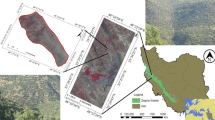Abstract
The purpose of this investigation was to develop a method to determine the spatial pattern of trees as a robust indicator to monitor changes from B&W aerial photographs in Persian oak forests of Zagros, Iran. A 500 × 600 m study area was selected in Servak forests next to Yasuj city in Kohgiluyeh-Va-BuyerAhmad Province. All the trees were tagged in the study area and the point map of stems were prepared. The spatial distribution of trees was determined as “dispersed” using nearest neighbour technique. Then the index of “C” calculated by T-square sampling method was applied to the point map of the study area in 30 systematic sample points in a 100 × 100 m network. Comparing the results of this method with the true spatial pattern of the study area showed that “C” can detect the spatial arrangement of trees. Thereafter the index was used on the air photo of the study area that was made of B&W aerial photographs. The method suggested in this study provides a suitable approach for detecting the spatial pattern of trees in Zagros forests on B&W air photos.
Similar content being viewed by others
References
Clark, P. J., & Evans, F. C. (1954). Distance to nearest neighbour as a measure of spatial relationships in population. Ecology, 35, 445–453.
Dale, M. R. T. (1999). Spatial pattern analysis in plant ecology. UK: Cambridge University Press.
Diggle, P. (1982). Some statistical aspects of spatial distribution models for plants and trees. Studia Forestalia Suecica Nr. 162.
Franklin, S. E. (2001). Remote sensing for sustainable forest management. USA: Lewis Publishers.
Ghazanfari, H., Namiranian, M., Sobhani, H., & Mohajer, M. R. M. (2004). Traditional forest management and its application to encourage public participation for sustainable forest management in the northern Zagros Mountains of Kurdistan province, Iran. Scandinavian Journal of Forest Research, 19(Suppl. 4), 65–71.
Haara, A., & Haarala, M. (2002). Tree species classification using semi-automatic delineation of trees on aerial images. Scandinavian Journal of Forest Research, 17, 556–565.
Jazirehi, M., & Rostaghi, M. E. (2003). Zagros silviculture. Iran: Tehran University Press (In Persian).
Kint, V., Robert, D. W., & Noel, L. (2004). Evaluation of sampling methods for the estimation of structural indices in forest stands. Ecological Modelling, 180, 461–476.
Korpela, I. (2004). Individual Tree Measurements by means of digital photogrammetry. Silva Fennica, Monographs 3.
Legendre, P., & Legendre, L. (1998). Numerical ecology (2nd ed.). The Netherlands: Elsevier.
Lo, C. P., & Yeung, A. K. W. (2007). Concepts and techniques in Geographic Information System. USA: Pearson Education.
Loetsch, F., Zohrer, F., & Haller, K. E. (1973). Forest inventory. vol. 2. Germany: BLV Verlagsgesellshaft mbH.
Ludwig, J. A., & Reynolds, J. F. (1988). Statistical ecology. USA: John Wiley & Sons.
Mitchell, A. (2005). The ESRI guide to GIS analysis. vol. 2. USA: ESRI Press.
Nelson, T., Niemann, K. O., & Wulder, M. A. (2002). Spatial statistical techniques for aggregating point objects extracted from high spatial resolution remotely sensed imagery. Geographic Systems, 4, 423–433.
Pourhashemi, M., Mohajer, M. R. M., Zobeiri, M., Zahedi, G., & Panahi, P. (2004). Identification of forest vegetation units in support of government management objectives in Zagros forests, Iran. Scandinavian Journal of Forest Research, 19(Suppl. 4), 72–77.
Sabeti, H. (2002). Forests, trees and shrubs of Iran. Iran: YAZD University Press (In Persian).
Sagheb-Talebi, K., Sajedi, T., & Yazdian, F. (2003). Forests of Iran. Iran: Research Institute of Forests and Rangelands, Forest Research Division.
Salas, C., LeMay, V., Nunez, P., Pacheco, P., & Espinosa, A. (2006). Spatial patterns in an old-growth Nothofagus obliqua forest in south-central Chile. Forest Ecology and Management, 231, 38–46.
Scheuder, H. T., Gregoire, T. G., & Wood, G. B. (1993). Sampling methods for multiresource forest inventory. USA: John Wiley & Sons.
Sebego, R. J. G., & Arnberg, W. (2002). Interpretation of mopane woodlands using air photos with implication on satellite image classification. International Journal of Applied Earth Observation and Geoinformation, 4, 119–135.
Shimatani, K., & Kubota, Y. (2004). Spatial analysis for continuously changing point patterns along a gradient and its application to an Abies sachalinensis population. Ecological Modelling, 180, 359–369.
Wolf, A. (2005). Fifty year record of change in tree spatial patterns within a mixed deciduous forest. Forest Ecology and Management, 215, 212–223.
Wong, D. W. S., & Lee, J. (2005). Statistical analysis of geographic information with ArcView GIS and ArcGIS. USA: John Wiley & Sons.
Wulder, M. A., Niemann, K. O., & Nelson, T. (2004). Comparison of airborne and satellite high resolution data for the identification of individual trees with local maxima filtering. International Journal of Remote Sensing, 25(11), 2225–2232.
Yang, T. Y., & Lee, J. C. (2007). Bayesian nearest-neighbor analysis via record value statistics and nonhomogeneous spatial Poisson processes. Computational Statistics & Data Analysis, 51(9), 4438–4449.
Author information
Authors and Affiliations
Corresponding author
Rights and permissions
About this article
Cite this article
Erfanifard, Y., Feghhi, J., Zobeiri, M. et al. Spatial pattern analysis in Persian oak (Quercus brantii var. persica) forests on B&W aerial photographs. Environ Monit Assess 150, 251–259 (2009). https://doi.org/10.1007/s10661-008-0227-4
Received:
Accepted:
Published:
Issue Date:
DOI: https://doi.org/10.1007/s10661-008-0227-4




